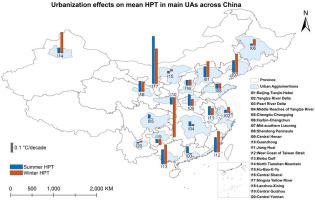Urban Climate ( IF 6.4 ) Pub Date : 2021-07-13 , DOI: 10.1016/j.uclim.2021.100910 Peng Wang 1, 2 , Ming Luo 1, 2, 3 , Weilin Liao 1, 2 , Yong Xu 4 , Sijia Wu 1, 2 , Xuelin Tong 1, 2 , Hao Tian 1, 2 , Feng Xu 1, 2 , Yu Han 1, 2

|
People in urban agglomerations (UAs) are increasingly exposed to elevated extreme temperature events under global warming and local human activities such as urbanization. While the urbanization effects on local temperature changes have been well studied, possibly different effects on human perceived temperature (HPT), which measures the compound influences of multiple indicators (e.g., temperature, humidity, and wind), remain much less understood. Here, we examine the long-term changes in mean and extreme HPT in 20 major UAs across the mainland of China since the 1970s, and evaluate the effect of urbanization based on a dynamic classification of urban and rural stations using time-varying land use/land cover maps. The results show that mean HPT and actual near-surface air temperature (T) in both summer and winter seasons display significant trends in most portions of China, while the frequency of extreme HPT and T events in summer (winter) exhibits increasing (decreasing) tendency. These trends are particularly stronger in more populated and urbanized UAs. It is estimated that urbanization averagely accounts for around 1/6 of the total increasing trend in mean HPT and T in the urban core areas of 20 UAs. In both seasons, the effects of urbanization on mean HPT are more profound than T. Moreover, urbanization significantly increases the occurrence frequency of summertime hot extremes and decreases the occurrence of wintertime cold events. Regionally, northern UAs in general exhibit more remarkable trends than the south. The urbanization process exerts more prominent effects in HPT than T in nearly three-quarters of all UAs, except several regions with a complex topography and lower urbanization level. These findings reported here can provide suggestions and support for urban planning of decision-maker and human perceived thermal comfort choices of humans living in UAs.



























 京公网安备 11010802027423号
京公网安备 11010802027423号